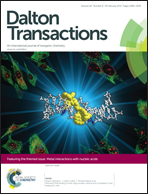UV-visible spectroscopy of macrocyclic alkyl, nitrosyl and halide complexes of cobalt and rhodium. Experiment and calculation†
Abstract
Transition metal complexes (NH3)5CoX2+ (X = CH3, Cl) and L(H2O)MX2+, where M = Rh or Co, X = CH3, NO, or Cl, and L is a macrocyclic N4 ligand are examined by both experiment and computation to better understand their electronic spectra and associated photochemistry. Specifically, irradiation into weak visible bands of nitrosyl and alkyl complexes (NH3)5CoCH32+ and L(H2O)MIIIX2+ (X = CH3 or NO) leads to photohomolysis that generates the divalent metal complex and ˙CH3 or ˙NO, respectively. On the other hand, when X = halide or NO2, visible light photolysis leads to dissociation of X− and/or cis/trans isomerization. Computations show that visible bands for alkyl and nitrosyl complexes involve transitions from M–X bonding orbitals and/or metal d orbitals to M–X antibonding orbitals. In contrast, complexes with X = Cl or NO2 exhibit only d–d bands in the visible, so that homolytic cleavage of the M–X bond requires UV photolysis. UV-Vis spectra are not significantly dependent on the structure of the equatorial ligands, as shown by similar spectral features for (NH3)5CoCH32+ and L1(H2O)CoCH32+.


 Please wait while we load your content...
Please wait while we load your content...